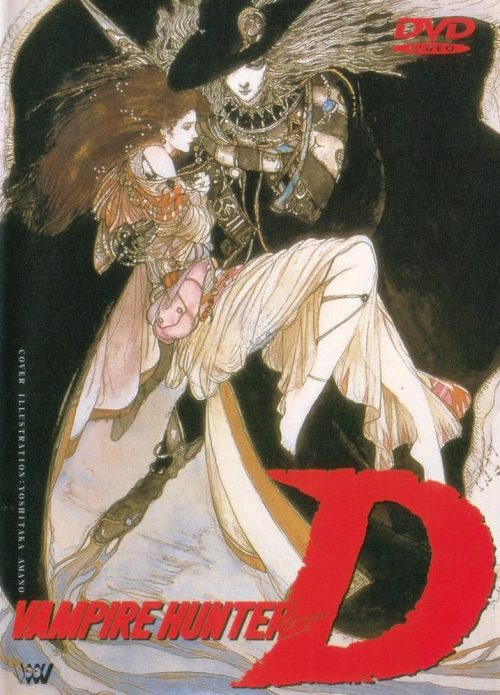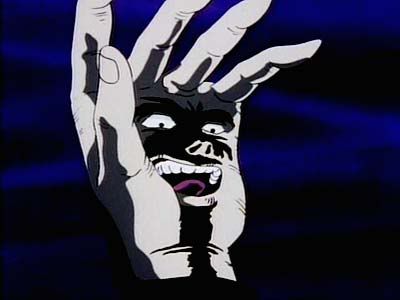 |
| From https://41.media.tumblr.com/c2a3162baa311844f2b7d7 c070267079/tumblr_nn6dycyAiD1spaq6ho1_500.jpg |
Director: Toyoo Ashida
Screenplay: Yasushi Hirano
Based on the light novels by Hideyuki
Kikuchi
Cast: Kaneto Shiozawa/Michael
McConnohie (as D); Michie Tomizawa/Barbara Goodson (as Doris Lang); Satoko
Kitô/Edie Mirman (as Lamika); Seizo Katou/Jeff Winkless (as Count Magnus Lee);
Ichirô Nagai (as Left Hand); Kazuyuki Sogabe/Kerrigan Mahan (as Rei Ginsei)
Watched with English Dub
 |
| From http://static1.squarespace.com/static/5138a6d4e4b0908a3a990080/t/ 52e435e7e4b0eeee546814ba/1390687722352/vampire-hunter-d-conde-magnus-lee.jpg |
Having only known of Vampire Hunter D through its two
animated adaptations, the one I'm covering today and the more critically
acclaimed follow up from 2000 by Yoshiaki
Kawajiri, I'm a novice in my knowledge of a momentous pop cultural
franchise. Like (entry # 16) Galerians:
Rion (2002), I first heard of the franchise through a videogame tie-in in
one of my old Playstation One
magazines, though its origin as a series of light novels would go on to spawn
many a tie-in beyond that game. A huge factor to these books' reputation is the
art by Yoshitaka Amano, whose work if
you research him on Google is some of
the most beautiful and artistically satisfying to be created for a Japanese pop
cultural object. His work and Vampire
Hunter D in general, including the anime adaptations, are heavily
influenced by European art and genre motifs, to the point the most beloved of
the two anime, Vampire Hunter D:
Bloodlust by Kawajiri, was a
US-Japanese co-production where the English dub came first.
 |
| From https://i.ytimg.com/vi/mPuu9HNUcN4/hqdefault.jpg |
The influences and how Vampire Hunter D used them to create
its unique world is ultimately the best virtue of the 1985 version alongside
its OVA quality animation. Melding Gothic horror with the post-apocalyptic,
with frontier western vibes crashing against post-medieval towns, it envisions
a world thousands of years in the future where, after a calamity, mankind
survives in a society scattered across apocalyptic wasteland where demons and
mutants gladly co-exist, where werewolves prowl the lands and, in lieu of the
title, vampires stalk the night and require paid vampire hunters to eliminate. A
dhampir named D, half vampire and half mortal man, wanders the landscape being
paid for jobs, the only constant being his left hand which, with a human face,
is sentient and cannot shut up, mocking his attempts at resisting his vampiric
blood. The plot is pretty basic after this established character is introduced over
eighty minutes, a young woman named Doris Lang hiring D after an ancient
vampire Count Magnus Less has marked her to be his bride. Like a lot of pulpy
characters, as much in anime like this, its these characters including those
introduced for a single story that bring out the personality, the plot
thickened by a mutant who'll gladly help the Count in hope for immortality and
the Count's own daughter Lamika who is appalled about both the idea of a mortal
peasant joining their royal lineage and becoming her mother-in-law.
 |
| From http://img.photobucket.com/albums/v517/ richardsplash/INVASIAN/VampireHunterD2.jpg |
The basic nature of said plot,
where D has to repeatedly struggle against new obstacles each scene, from
ghouls to the aforementioned mutant, means that the entertainment is in the
world itself being depicted onscreen. Horror, as mentioned in previous posts
last year for Halloween, is a surprisingly neglected genre in anime, only
starting to pick up in amount within the last ten years and especially with
stuff like Tokyo Ghoul (2014)
getting popular in animated and paperback form. While action orientated, seeing
a Japanese work entirely devout to a fetish of European horror, even in the big
eyed eighties character designs, is utterly welcoming. The melding of science fiction and gothic
horror manages, despite being potentially awkward bedfellows, to work in these
two anime adaptations, reined in by the general tone and looks of both. They
exhibit one of the most extreme, but ultimately satisfying, examples of a genre
melting pot in how many influences there are - period townsfolk and frontier western
clothing against robot horses, the vampire count dressed like Bela Lugosi against the bloodier
violence of straight-to-video anime - and yet because of the art style this
first adaptation makes it all seamlessly work together.
 |
| From https://thomfiles.files.wordpress.com/2012/06/vampire-hunter-d.jpg |
The animation style does add to
the film immensely. The only real botch to this version decades on is that the
female lead occasionally looks like a twelve year old in scenes, even in the
context of the eighties character designs, certainly cringe worthy when you
notice it when there's a scene where she melancholically tries to seduce D only
for him to struggle with wanting to bite her neck. The gothic, realistic
character designs of the 2000 version are the best, but as a film meant to
bring the D character and his world to the video screen, the original eighties version
is still handsome in quality and gets right the most important of the story in
terms of the fantastical nature of it. Against anything from giants to an
imp-like witch, the protagonist D exists in a world of the phantasmagoric melded
with sci-fi; where the ruined castles would have to be dank and oppressive,
where the pits below have the centuries old skeletons laid about from a war and
snake women to seduce people, as the post-apocalyptic content is as
appropriately bleak. The more unconventional aspects, such as D's talking hand,
add to this is giving the film its own distinct personality. The only thing
that spoils the general mood that is so well added are that, one, the original
English dub is terrible with stilted line readings and, two, the end credit
song is a wildly inappropriate New Wave influenced J-pop number, especially
after the ending takes on both a sudden abstract series of seasonal changes and
both a sombre, clean act of saying goodbye. The dub is only a problem depending
on the version of Vampire Hunter D
you see; now with the recent American re-release of the film, the company
realising it Sentai Films had to
create a new English dub due to the original dub's materials being too damaged
for restoration. The end credit song however is one you're stuck with.




